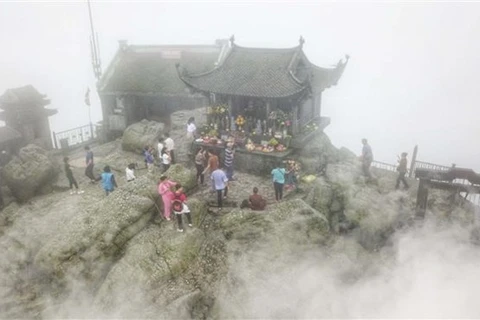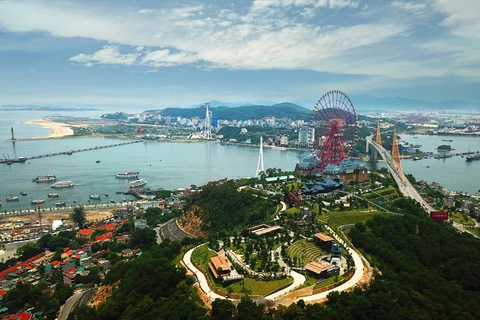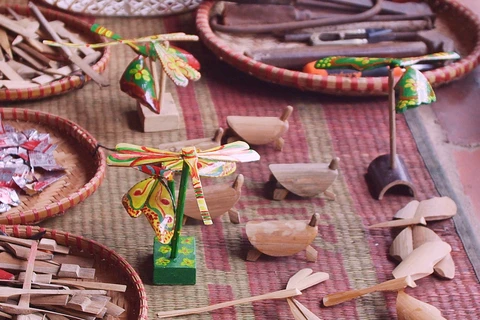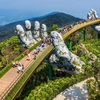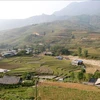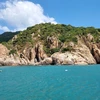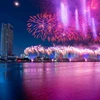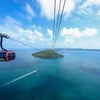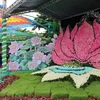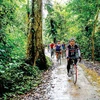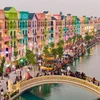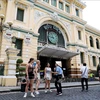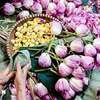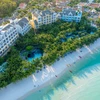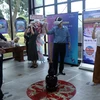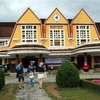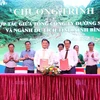Hanoi (VNA) - The beauty of Yen Tu is the grandeur and tranquility of the mountains and forests mingled with the serenity and ancientness of the system of pagodas, towers and Zen realms.
Yen Tu has become a Buddhist centre of Vietnam since King Tran Nhan Tong gave up the throne, put on a monk's robes and established a typical Buddhist sect of Vietnam, namely Truc Lam Zen Buddhism.
He built hundreds of large and small works on Yen Tu Mountain as places for practicing and preaching Buddhism.
Existing cultural and historical vestiges in Yen Tu are hundreds of stupas; dozens of pagoda foundations under the Tran and Le dynasties beneath restored pagodas; thousands of ancient objects such as statues, bells, steles, tiles, bricks, porcelain and crockery... with unique and creative motifs, patterns and architecture.
The Truc Lam Zen Buddhist sect gathers full of the spirit of Buddhism, but still contains the unique features of Vietnam.
Therefore, Yen Tu is also considered the Buddhist capital of Vietnam. From Yen Tu, Truc Lam teachings have spread throughout the northeastern region, with hundreds of large and small pagodas built, including famous ones such as Quynh Lam, Con Son, Thanh Mai, etc.
Until the Le and Nguyen dynasties, Yen Tu was still the center of Vietnamese Buddhism. Restored and repaired by the kings of the dynasties, the Yen Tu relic site is the crystallization and convergence of the national culture with architecture, decorative patterns and carved items bearing the hallmarks of the dynasties.
There are hundreds of temples and tombs of Zen masters, natural statues, Buddha steles and especially the Bao Sai cave where Tran Nhan Tong, the founder of the Zen Buddhist sect, sat and meditated on January 1, 1308. The system of pagodas and stupas in Yen Tu is located on the east side of the mountain.
In the two great wars of national defence in the 20th century, Yen Tu was a revolutionary base where soldiers trained and guarded the skies of Vietnam.
Excluding Bi Thuong pagoda at the foot of the Do (Red) slope, Cam Thuc pagoda in Uong Bi and Lan pagoda in Nam Mau village, the road to Yen Tu starts from Gia Oan, Hoa Yen and Cong Troi pagodas, and then Pho Da and Bao Sai pagodas and finishes at Dong pagoda located at the highest point of Yen Tu mountain range.
Some of the main Buddhist sites and architectures in Yen Tu are Bi Thuong pagoda, Cam Thuc pagoda, Lan pagoda, Giai Oan pagoda, Hoa Yen pagoda, Bao Sai pagoda and Dong pagoda.
The special historical-cultural values have made Yen Tu a sacred place in the spiritual life of Vietnamese people.
In order to affirm the special value of the relic site, the Prime Minister decided to rank the Yen Tu historic relic and landscape site as a special national relic site (Decision No. 1419/QD-TTg dated September 27, 2012).
Yen Tu has become a Buddhist centre of Vietnam since King Tran Nhan Tong gave up the throne, put on a monk's robes and established a typical Buddhist sect of Vietnam, namely Truc Lam Zen Buddhism.
He built hundreds of large and small works on Yen Tu Mountain as places for practicing and preaching Buddhism.
Existing cultural and historical vestiges in Yen Tu are hundreds of stupas; dozens of pagoda foundations under the Tran and Le dynasties beneath restored pagodas; thousands of ancient objects such as statues, bells, steles, tiles, bricks, porcelain and crockery... with unique and creative motifs, patterns and architecture.
The Truc Lam Zen Buddhist sect gathers full of the spirit of Buddhism, but still contains the unique features of Vietnam.
Therefore, Yen Tu is also considered the Buddhist capital of Vietnam. From Yen Tu, Truc Lam teachings have spread throughout the northeastern region, with hundreds of large and small pagodas built, including famous ones such as Quynh Lam, Con Son, Thanh Mai, etc.
Until the Le and Nguyen dynasties, Yen Tu was still the center of Vietnamese Buddhism. Restored and repaired by the kings of the dynasties, the Yen Tu relic site is the crystallization and convergence of the national culture with architecture, decorative patterns and carved items bearing the hallmarks of the dynasties.
There are hundreds of temples and tombs of Zen masters, natural statues, Buddha steles and especially the Bao Sai cave where Tran Nhan Tong, the founder of the Zen Buddhist sect, sat and meditated on January 1, 1308. The system of pagodas and stupas in Yen Tu is located on the east side of the mountain.
In the two great wars of national defence in the 20th century, Yen Tu was a revolutionary base where soldiers trained and guarded the skies of Vietnam.
Excluding Bi Thuong pagoda at the foot of the Do (Red) slope, Cam Thuc pagoda in Uong Bi and Lan pagoda in Nam Mau village, the road to Yen Tu starts from Gia Oan, Hoa Yen and Cong Troi pagodas, and then Pho Da and Bao Sai pagodas and finishes at Dong pagoda located at the highest point of Yen Tu mountain range.
Some of the main Buddhist sites and architectures in Yen Tu are Bi Thuong pagoda, Cam Thuc pagoda, Lan pagoda, Giai Oan pagoda, Hoa Yen pagoda, Bao Sai pagoda and Dong pagoda.
The special historical-cultural values have made Yen Tu a sacred place in the spiritual life of Vietnamese people.
In order to affirm the special value of the relic site, the Prime Minister decided to rank the Yen Tu historic relic and landscape site as a special national relic site (Decision No. 1419/QD-TTg dated September 27, 2012).
For many years, the spiritual tourism complex in Yen Tu mountain area has been continuously preserved, embellished and built to meet the increasing demands of Buddhists, domestic and foreign tourists on pilgrimage to the land of the Buddha in every early spring.
Yen Tu Mountain is located about 50 kilometres from Ha Long city. The area has awe-inspiring scenery, surrounded by ancient pagodas and hermitages.
Tran Nhan Tong (1258-1308), the third King of the Tran Dynasty (1225-1400), ascended to the throne when he was just 21. He was famed for defeating Mongol invaders twice during his 15-year reign.
The king abdicated when he was 35 and spent the rest of his life on Yen Tu Mountain practicing and propagating Buddhism. He founded the first Vietnamese School of Buddhism called “Thien Tong” or Truc Lam Yen Tu Zen on the 1,068m-high Yen Tu Mountain. The 20,000ha site is considered the capital of Vietnamese Buddhism.
Yen Tu became a major Buddhist Centre and King Tran Nhan Tong became its first leader under the religious name Dieu Ngu Giac Hoang Tran Nhan Tong. He ordered the construction of hundreds of religious buildings on Yen Tu mountains for teaching and following a religious life.
Yen Tu Mountain is located about 50 kilometres from Ha Long city. The area has awe-inspiring scenery, surrounded by ancient pagodas and hermitages.
Tran Nhan Tong (1258-1308), the third King of the Tran Dynasty (1225-1400), ascended to the throne when he was just 21. He was famed for defeating Mongol invaders twice during his 15-year reign.
The king abdicated when he was 35 and spent the rest of his life on Yen Tu Mountain practicing and propagating Buddhism. He founded the first Vietnamese School of Buddhism called “Thien Tong” or Truc Lam Yen Tu Zen on the 1,068m-high Yen Tu Mountain. The 20,000ha site is considered the capital of Vietnamese Buddhism.
Yen Tu became a major Buddhist Centre and King Tran Nhan Tong became its first leader under the religious name Dieu Ngu Giac Hoang Tran Nhan Tong. He ordered the construction of hundreds of religious buildings on Yen Tu mountains for teaching and following a religious life.
The Yen Tu Spring Festival takes place in Uong Bi city, Quang Ninh province on the 10th day of the Lunar New Year./.
VNA

